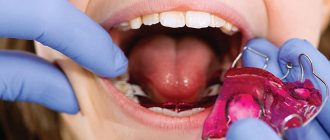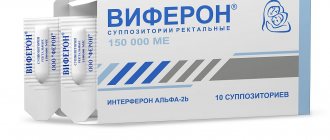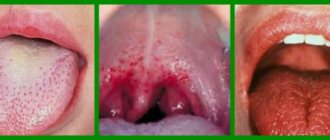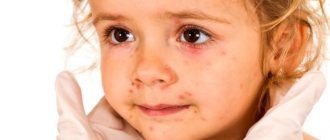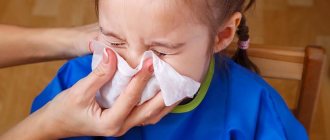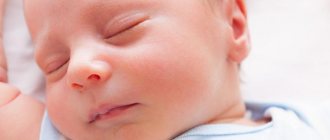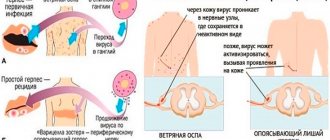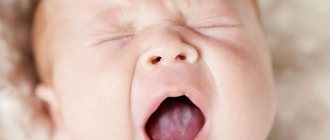Like any other pathological conditions, there can be reasons for a runny nose in infants.
- physiological;
- pathological.
Physiological reasons
The mucous membrane of the nasal cavities immediately after birth, although formed correctly, cannot fully perform its functions and participate in the regulatory mechanisms of the body. In some children, this leads to excessive dryness of the nasal cavity with insufficient secretion production, while in others it leads to excessive secretion - a newborn runny nose.
The functioning of the mucous membrane returns to normal only after reaching 10 months of age. There's no need to worry. This is not dangerous and should go away on its own over time, but the ENT doctors at Dr. Korenchenko’s clinic advise you to see a pediatrician. so as not to miss the beginning of the development of the pathological process behind the imaginary well-being.
Pathological causes
The most common cause is colds, which newborns suffer from especially often. Your own immunity has not yet been formed, and your mother’s is not always effective enough and, moreover, weakens every day. Any infection that goes completely unnoticed in an adult or older child can cause acute respiratory infections and a runny nose in a newborn.
The first symptoms of an acute infectious disease are a rise in temperature and a runny nose in the baby. Later, cough, shortness of breath, and difficulty breathing occur. Sleep and appetite disorders. The child becomes restless, cries, and refuses to eat. Excessive snot in a baby causes irritation of the skin around the nose, on the upper lip, and in the nasolabial folds. At the first appearance of such symptoms, we strongly advise you to immediately contact your pediatrician.
Another common cause of a runny nose in a newborn is an allergic reaction to an external irritant. With age and with the formation of one’s own full-fledged immune defense, this disease can go away on its own, but in infancy, intolerance to any substances is more common than in adults. Irritants can be ordinary household dust, the hair of pets or birds, foreign odors, creams and preparations that are used to treat the baby’s skin, even the smell of the mother and breast milk can provoke snot in a baby.
A relatively uncommon cause of snot in infants is vasomotor rhinitis, a disease associated with impaired blood supply to the nasal mucosa. Only a doctor can make a correct diagnosis.
The difference between acute respiratory infections and acute respiratory viral infections, colds and flu
There are several key differences:
- Various pathogens
- influenza virus, rhinovirus infections, etc. Identifying the cause of the disease is very important for proper treatment and the absence of complications. - Different clinical picture
: influenza is a sudden onset, a sharp jump in body temperature, symptoms of intoxication (headaches and muscle pain, chills, body aches, adynamia, dry cough against the background of chest pain), inflammation of the mucous membrane lining the upper respiratory tract; - the first manifestation of acute respiratory infections, ARVI is inflammation of the mucous membrane of the upper respiratory tract (runny nose, sore throat, bronchitis, wet cough) - and only then the temperature rises (rarely above 38°).
Advantages of the Aqualor Baby children's series
To care for the nasal cavity of a newborn, it is advisable to use ready-made preparations, the sterility of which is guaranteed. Aqualor baby drops and spray with a “soft shower” attachment contain natural sea water and do not contain artificial additives, so they can be used without harm from the first days of life both for hygienic procedures and for the treatment of rhinitis of various etiologies.
Natural microelements of sea water stimulate the formation of local immunity, increasing the resistance of the nasal mucosa to microorganisms.
How to rinse a child's nose with saline solution? When using drops, the baby is placed on his back and, without plunging the tip of the bottle deep into the nose, squeeze 2-3 drops into each nostril. When using a spray, the solution is injected into the child's nasal cavity with the body in an upright position, preferably sitting in the arms of an adult (if the child already knows how to sit). In this case, the child's head should be straight and slightly tilted forward. The tip of the balloon is inserted into one of the halves of the nose, pressed on the sprayer and held for several seconds, thus rinsing this half of the nose. Then repeat the procedure with the other half of the nose.
The procedure can precede aspiration or be carried out in the morning and evening as part of daily hygiene. In conditions of dry, heated air, it is advisable to periodically irrigate the nasal passages using a spray.
Symptoms and signs of acute respiratory infections in children
Symptoms vary depending on the location of the inflammatory process:
- pharynx: pain and dryness in the throat;
- nose: mucus discharge, stuffiness, sneezing;
- larynx: dry cough, hoarse voice;
- tonsils: redness of the palate, swelling, plaque, pain;
- trachea: congestion behind the sternum, dry cough;
- bronchi: at the beginning of an acute respiratory infection the child has a dry cough, after some time has passed - a cough with sputum production. Source: L.A. Balykova, Doctor of Medical Sciences, corresponding member. RAS, T.I. Razdolkina, Candidate of Medical Sciences, Associate Professor Acute respiratory diseases in children // Remedium Privolzhye, 2018, No. 3(163), pp. 18-22
Due to the peculiarity of the anatomy of the respiratory tract (in children they are narrower) and the high predisposition of the mucous membranes to swelling, symptoms of obstruction and congestion often appear.
How many days does a child have a fever with acute respiratory infections? An increase in body temperature is a sign of an infectious process in the body and a reaction to inflammation. This is a protective function - this is how the body fights infection. At elevated temperatures, immune reactions are stimulated.
How many days a child with acute respiratory infections will have a fever depends on the correctness of treatment and general health. Along with it, muscle pain, general weakness, headache, soreness of the eyeballs usually appear, and rarely, vomiting and fainting.
A temperature of up to 37°C can be observed in a child even after an acute respiratory infection. In this case, there is no cause for concern if you remain in good health, blood, urine and stool tests are normal, and a medical examination did not reveal any pathology.
Diagnostics
The diagnosis is made on the basis of differential diagnosis, examination by a pediatrician, and laboratory tests. Clinical and epidemiological data are taken into account. The examination includes: a general urine test, a clinical blood test, immunofluorescence (to identify specific antigens in the nose and oropharynx), if necessary, a coagulogram, blood biochemistry, radiography, ultrasound, LHC culture from the oropharynx, urine, blood, and cerebrospinal fluid.
Diagnosis of vasomotor rhinitis
Correct treatment is preceded by an accurate diagnosis. To determine the form of a runny nose, the following studies may be required3:
- Examination using an endoscope, x-ray;
- Sinus swab;
- General clinical blood test;
- Allergy tests;
- Immunogram.
Diagnosis focuses on excluding infectious rhinitis and problems of an allergic nature. It is customary to treat disorders in the area of the nasal mucosa in ways other than those used to treat allergic and catarrhal rhinitis.
Treatment of acute respiratory infections in children, effective relief of symptoms
Recommendations on how to treat acute respiratory infections in children are aimed at relieving clinical manifestations associated with the inflammatory reaction.
Recommendations on how to treat acute respiratory infections in children are aimed at relieving clinical manifestations associated with the inflammatory reaction.
- a diet rich in vitamins;
- drinking plenty of water;
- antipyretic drugs.
Locally, symptoms are relieved by the following means:
- for nasal congestion - with vasoconstrictor drops;
- if the throat is affected - with sprays, local antiseptics, gargles;
- to relieve a wet cough - with expectorants;
- for dry cough - antitussives. Source: T.A. Samsygina Modern treatment of acute respiratory diseases in children // Pediatrics, 2013, No. 3, pp. 38-42
Inhalations and physiotherapy may also be prescribed.
Antibiotic treatment for acute respiratory disease is prescribed to children when the causative agent is a bacterial infection; only a doctor should give clinical recommendations, select the drug and dosage. If a child is prescribed an antibiotic for the flu, it is necessary to relieve complications that arise from bacterial damage (for example, pneumonia). In general, antibacterial drugs are powerless against viruses.
Doctors recommend avoiding antibiotics for uncomplicated respiratory viral infections. Their use is not justified even with mucopurulent runny nose lasting less than 2 weeks. Source: Seto WH, Conly JM, Pessoa-Silva CL et al Infection prevention and control measures for acute respiratory infections in healthcare settings: an update // East Mediterr Health J., 2013, i9 (Suppl. i), p. 39-47
Signs of a bacterial infection for which antibiotics are indicated:
- anaerobic sore throat;
- purulent processes;
- acute tonsillitis when group A streptococcus is detected;
- sinusitis, if clinical changes persist in the sinuses after 2 weeks from the onset of the disease;
- acute otitis media;
- pneumonia;
- chlamydia and mycoplasmosis (respiratory form);
- bronchitis caused by mycoplasma (mycoplasma bronchitis).
The child is required to have bed rest
until body temperature normalizes,
eat a balanced diet, take multivitamins
. You can gargle with decoctions of medicinal herbs, infusions, and antiseptic solutions. If the body temperature is normal, then the following will be useful: dry heat on the lower back and feet, hot foot baths.
Nasal hygiene
Physiological runny nose does not require correction with medications. At the same time, it is necessary to help the baby get rid of excess mucus, which makes nasal breathing difficult. For this purpose, cotton swabs moistened with saline are used. They are placed in the nasal passages and then removed with twisting movements.
Mechanical or electric aspirators are more effective. The Aqualor Baby aspirator is easy to use. The innovative mucus capture system in the Aqualor Baby aspirator ensures a hygienic procedure - during aspiration, mucus accumulates in a special reservoir. The comfortable mouthpiece has teeth holders, making the suction procedure convenient. The ergonomic body has a special recess for easy grip - the aspirator does not slip out of the hand during the procedure.
A few minutes before the procedure, 2-3 drops of a sterile isotonic solution are instilled into the nose, preferably one based on sea water, such as Aqualor Baby spray or drops. This helps to thin the exudate and dissolve crusts and clots, which increases the effect of aspiration. Usually the procedure is carried out 3-5 times a day.
Prevention of acute respiratory infections and acute respiratory viral infections in children
Prevention of acute respiratory infections should include, first of all, protection in children from sources of infection with acute respiratory diseases
, during periods of epidemic, it is recommended to wear a medical mask in kindergarten and school. In addition, you must:
- provide the child with vaccinations on schedule and during the epidemic;
- avoid hypothermia;
- carry out hardening;
- feed the child correctly - in a balanced manner, according to a schedule, with food rich in vitamins;
- spend less time in public places during outbreaks;
- at the first signs of illness, consult a doctor, even if you need to miss school or kindergarten;
- walk more with your child in the fresh air;
- introduce general strengthening gymnastics into the child’s daily routine.
Sources:
- S.O. Klyuchnikov, O.V. Zaitseva, I.M. Osmanov, A.I. Krapivkin, E.S. Keshishyan, O.V. Blinova, O.V. Bystrova. Acute respiratory diseases in children (Manual for doctors) // Russian Bulletin of Perinatology and Pediatrics, 2008, supplement No. 3.2008.
- L.A. Balykova, Doctor of Medical Sciences, corresponding member. RAS, T.I. Razdolkina, candidate of medical sciences, associate professor. Acute respiratory diseases in children // Remedium Privolzhye, 2021, No. 3(163), pp. 18-22.
- T.A. Samsygina. Modern treatment of acute respiratory diseases in children // Pediatrics, 2013, No. 3, pp. 38-42.
- Seto WH, Conly JM, Pessoa-Silva CL et al. Infection prevention and control measures for acute respiratory infections in healthcare settings: an update // East Mediterr Health J., 2013, i9 (Suppl. i), p. 39-47.
Markova Daria Olegovna Clinic
Author of the article
Markova Daria Olegovna
Specialty: endocrinologist
Experience: 14 years
The information in this article is provided for reference purposes and does not replace advice from a qualified professional. Don't self-medicate! At the first signs of illness, you should consult a doctor.
In what other cases should you call a doctor if you have a cold?
- You think your child has a life-threatening situation
- Non-severe breathing problems that do not go away after clearing the nose.
- High-risk child (eg, with chronic lung disease)
- Weak immune system: sickle cell disease, HIV, cancer, organ transplant, oral steroid use.
- Temperature above 40°C
- Fever in a baby less than 12 weeks old.
- Ear pain or ear discharge
- Yellow or green pus from the eyes
- Fever lasts more than 3 days
- Fever returns after being gone for more than 24 hours
- Fever lasts more than 3 days or rises above 40 °C (104 °F).
- Nasal discharge continues for more than 14 days.
- Cough lasts more than 3 weeks
Prices
| Name of service (price list incomplete) | Price |
| Online opinion of a pediatrician (SPECIAL) | 0 rub. |
| Appointment (examination, consultation) with a pediatrician, primary, therapeutic and diagnostic, outpatient | 1750 rub. |
| Consultation (interpretation) with analyzes from third parties | 2250 rub. |
| Prescription of treatment regimen (for up to 1 month) | 1800 rub. |
| Consultation with a candidate of medical sciences | 2500 rub. |
